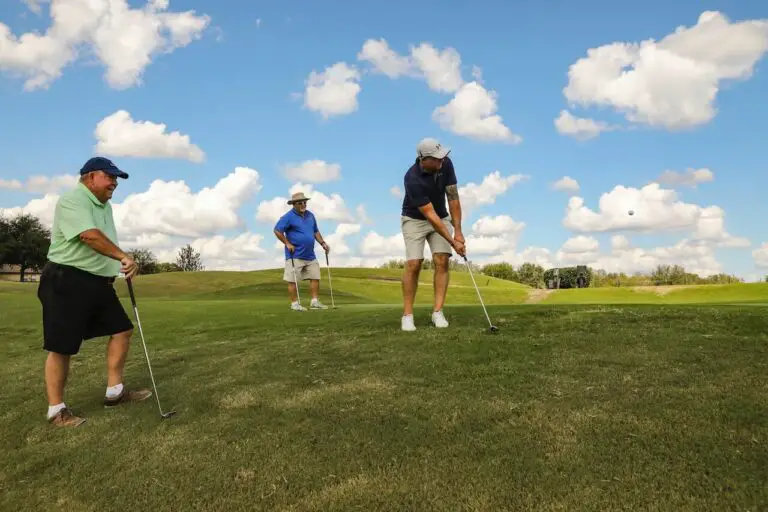Game-Improvement Tips For Beginner Golfers

To improve your golf game as a beginner, there are a few key things you can focus on. First, make sure you have the right equipment, including a set of clubs that are suited to your skill level and size. Second, work on your swing, paying attention to factors like your grip, posture, and alignment. Third, practice regularly, both on the driving range and on the course. Finally, consider taking lessons from a professional instructor who can help you fine-tune your technique and identify areas for improvement. With dedication and practice, you can steadily improve your golf game over time.
Use the right equipment
Using the right equipment is important because it can help you improve your game and enjoy the sport more. For beginners, using properly fitted clubs, game-improvement clubs, and beginner-level golf balls, for example, can all help you hit the ball farther and straighter, which can make the game more fun and rewarding.
Work on your grip
A proper grip is the foundation of a good golf swing, so be sure to hold the club correctly.
There are a few key things you can do to improve your golf grip. First, make sure you are holding the club with a relaxed grip. This will help you make smoother swings and avoid gripping the club too tightly, which can cause tension and lead to poor shots. Second, try using a grip that is slightly stronger than neutral. This means that your hands should be rotated slightly clockwise on the club for a right-handed golfer (or counterclockwise for a left-handed golfer). This will help you hit the ball with more control and accuracy. Finally, pay attention to the placement of your hands on the club. They should be evenly spaced and symmetrical, with your thumbs pointing down the shaft of the club. This will help you maintain a consistent grip and swing.
Focus on your posture
Make sure you have a good stance, with your feet shoulder-width apart and your weight evenly distributed. Good posture is an important aspect of a successful golf swing. Here are some tips for achieving good posture:
- Stand with your feet shoulder-width apart and your weight evenly distributed on both feet.
- Keep your knees bent slightly and your back straight.
- Tilt your hips slightly forward, but avoid slouching or leaning too far forward.
- Keep your arms relaxed and let them hang naturally at your sides.
- Keep your shoulders level and avoid letting them round forward or hunch up toward your ears.
- Hold the club with a light grip and avoid clenching it too tightly.
- Keep your head steady and look straight ahead. Avoid tilting your head or looking up or down.
It may take some practice to get the hang of good posture, but with time and effort, you should be able to achieve a comfortable and effective stance.
Practice your aim
Before you swing, take a moment to line up your shot and aim for your target. To improve your aim in golf, you can try the following tips:
- Start by setting up a target, such as a golf hole or a flag, to aim for on the practice green.
- Take a few practice swings to get a feel for the club and your stance.
- Focus on your alignment and aim before you take your shot. Make sure your feet, hips, and shoulders are aligned with the target.
- As you swing, keep your eyes on the target and follow through with your swing to maintain a consistent aim.
- After you hit the ball, take a moment to assess how well you hit it. Were you able to hit the target? If not, try to determine what went wrong and adjust your aim accordingly.
- Repeat this process until you feel confident in your aim.
Use your hips
In the backswing, be sure to pivot your hips to generate power and speed in your swing. Here are a few tips for using your hips in your golf swing:
- Start by setting up to the ball with your feet shoulder-width apart and your weight evenly distributed between both feet. This will give you a strong and stable base to work from.
- As you take your backswing, allow your hips to turn and rotate naturally. This will help you generate power and speed in your swing.
- On your downswing, let your hips lead the way. This will help you transfer your body weight forward and into the ball, which will increase your clubhead speed and help you hit the ball farther.
- As you make contact with the ball, keep your hips and lower body turning through the shot. This will help you create a smooth, fluid swing and maintain your balance.
- Finally, practice using your hips in your swing by hitting balls on the range and focusing on making a full, controlled turn with your lower body. This will help you develop muscle memory and improve your overall golf game.
Follow through
After you hit the ball, make sure to follow through and complete your swing. This will help you control the direction and distance of your shot. There are a few key things you can do to make sure you follow through on your golf swing:
- Make sure you have a clear plan for your swing before you start. This will help you stay focused and committed to following through.
- Use a mirror or video camera to check your form and make sure you are following through properly.
- Practice regularly and focus on maintaining good form and a consistent swing. This will help you build the muscle memory and control you need to follow through consistently.
- Pay attention to your grip, posture, and stance, as all of these can affect your ability to follow through on your swing.
- Lastly, try to relax and trust your swing. Tensing up or overthinking can lead to poor form and a lack of follow-through.
Keep your head down
It’s important to keep your eyes on the ball and your head down throughout the swing. This will help you stay focused and avoid swaying or lifting your head. Keeping your head down during your golf swing helps to ensure that you are able to maintain your balance and swing the club properly. If your head is up and you are looking up at the ball, you are likely to lose your balance and your swing will not be as effective. Keeping your head down also allows you to keep your eyes on the ball and make solid contact with the club. In general, maintaining good posture and keeping your head down during your swing is crucial for hitting the ball accurately and consistently.
Consider getting some lessons
There are many benefits to taking golf lessons, including improving your technique, learning new skills, and gaining a better understanding of the game. Golf lessons can help you to play more consistently, shoot lower scores, and enjoy the game more. They can also help you to develop a more effective practice routine and learn to troubleshoot problems with your swing. In addition, taking lessons from a qualified instructor can help to prevent injuries and improve your overall enjoyment of the game.
Relax and have fun
Golf can be frustrating at times, especially for beginners, so be sure to relax and enjoy the game. The more relaxed and comfortable you are, the better you will play. Here are some tips for relaxing and having fun on the golf course:
- Remember that golf is a game and it’s supposed to be enjoyable. Try not to take it too seriously and don’t put too much pressure on yourself.
- Make sure to warm up before you start playing. This can help you loosen up your muscles and get into a good mental state for the game.
- Try to focus on the present moment and enjoy the scenery around you. Golf courses are often beautiful, so take a moment to appreciate your surroundings.
- Play with friends or other golfers who are at a similar skill level. This can help create a more relaxed and enjoyable atmosphere on the course.
- If you’re having a bad round, don’t let it ruin your day. Take a deep breath, shake it off, and try to focus on the next shot.
- Finally, don’t be afraid to try something new on the course. Whether it’s a new club or a different shot, experimenting can add some excitement to your game and help you have more fun.






